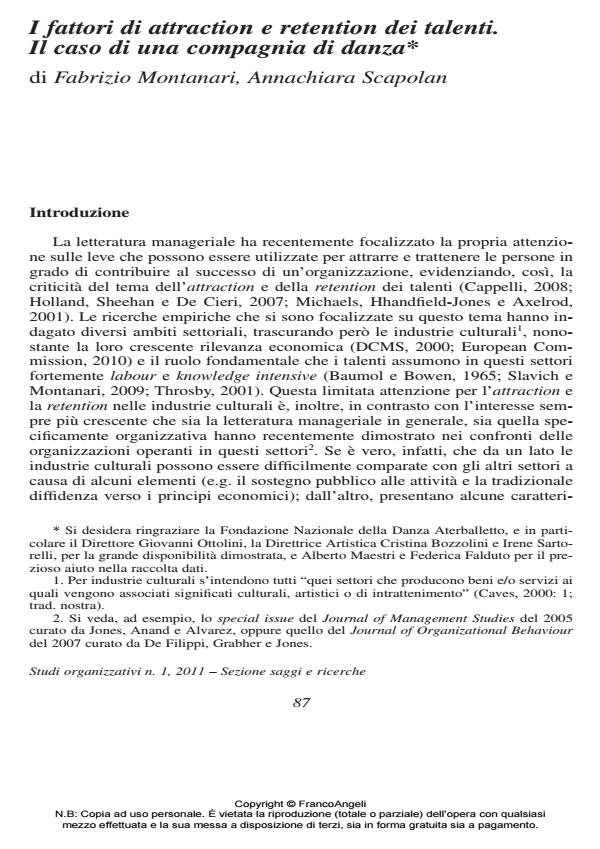I fattori di attraction e retention dei talenti. Il caso di una compagnia di danza
Titolo Rivista STUDI ORGANIZZATIVI
Autori/Curatori Fabrizio Montanari, Annachiara Scapolan
Anno di pubblicazione 2011 Fascicolo 2011/1
Lingua Italiano Numero pagine 25 P. 87-111 Dimensione file 532 KB
DOI 10.3280/SO2011-001004
Il DOI è il codice a barre della proprietà intellettuale: per saperne di più
clicca qui
Qui sotto puoi vedere in anteprima la prima pagina di questo articolo.
Se questo articolo ti interessa, lo puoi acquistare (e scaricare in formato pdf) seguendo le facili indicazioni per acquistare il download credit. Acquista Download Credits per scaricare questo Articolo in formato PDF

FrancoAngeli è membro della Publishers International Linking Association, Inc (PILA)associazione indipendente e non profit per facilitare (attraverso i servizi tecnologici implementati da CrossRef.org) l’accesso degli studiosi ai contenuti digitali nelle pubblicazioni professionali e scientifiche
Both management and academic literature have increasingly selected talents’ attraction and retention as an important area for research. Despite such a great attention devoted to this issue, there are still some under-investigated areas of interest. For example, previous research has devoted limited attention to cultural industries despite the fact that talents are the key asset of the organizations operating in these industries. Therefore, this paper aims at exploring this under-investigated issue by addressing three research questions. First, we will analyze a cultural organization’s characteristics that are able to attract and retain creative talents; second, we will investigate if attraction and retention are influenced just by organizational elements or also by external factors such as the city where the organization is located. Finally, we will analyze potential differences between attraction and retention factors. In doing so, we will analyze the case of the most important Italian dancing company - Fondazione della Danza Aterballetto. We combined different qualitative methods such as interviews, document analysis, and direct observation. Findings show that a cultural organization’s characteristics that are able to attract and retain creative talents are partially different from those highlighted by previous literature. In particular, the most important attraction factor seems to be the opportunity to work with the main choreographer, while the most important reasons to stay are represented by the creative process and the possibility to meet and work with other artists operating in different creative sectors. This opportunity is appreciated by the dancers who perceive Aterballetto as the centre of a relational network, which extends beyond the organizational boundaries. In the same way, the local socio-cultural context plays an important role in influencing the retention of dancers. Finally, the attraction factors are partially different from the retention ones. At the end of the paper, some possible future lines of research are presented and discussed.
Parole chiave:Talent management, performing arts, HRM, creativity
- Creatività e senso del luogo: uno studio sulle dinamiche identitarie in un cluster creativo Fabrizio Montanari, Damiano Razzoli, in STUDI ORGANIZZATIVI 1/2019 pp.64
DOI: 10.3280/SO2019-001003 - The impact of festivals on the image of a cultural industry: The case of the new Italian dance platform Ludovica Leone, Fabrizio Montanari, in Poetics 101630/2022 pp.101630
DOI: 10.1016/j.poetic.2021.101630
Fabrizio Montanari, Annachiara Scapolan, I fattori di attraction e retention dei talenti. Il caso di una compagnia di danza in "STUDI ORGANIZZATIVI " 1/2011, pp 87-111, DOI: 10.3280/SO2011-001004